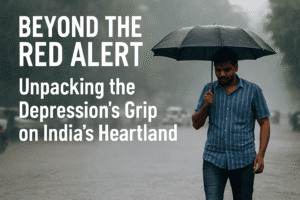Beyond the Red Alert: Unpacking the Depression’s Grip on India’s Heartland
A significant depression currently centered over West Bengal/Jharkhand is moving west-northwest, lashing the region with heavy rains that have already paralyzed Kolkata. The India Meteorological Department (IMD) has issued a severe Red Alert for July 26th, warning of extremely heavy, life-threatening rainfall in isolated areas of Maharashtra (especially Vidarbha and the Ghat regions), Chhattisgarh, and East Madhya Pradesh.
This intense rainfall threat shifts slightly westward to West Madhya Pradesh on July 27th. The depression’s slow movement prolongs exposure, leading to severe flooding, landslides in hilly areas (like sub-Himalayan Bengal and the Western Ghats), and major travel disruption. Goa and Odisha are also on alert. Residents in affected states must avoid travel, prepare for flooding, heed official warnings, and expect continued disruption for days ahead.

The India Meteorological Department’s (IMD) stark red alerts flashing across Maharashtra, Chhattisgarh, Madhya Pradesh, Goa, and Odisha signal more than just heavy rain – they mark the trail of a significant weather system disrupting lives across central and eastern India. Here’s what this evolving situation truly means for millions:
The Storm’s Path & Immediate Fury:
- Current Epicenter: The depression, having moved west-northwest from coastal West Bengal, now sits over Gangetic West Bengal and adjoining Jharkhand (near Purulia). Its slow, deliberate movement at 15 kmph amplifies rainfall duration.
- Ground Zero Impact (West Bengal/Jharkhand): Kolkata’s chaos on July 25th – severe waterlogging, paralyzed traffic, children wading through flooded streets – was the opening act. Expect continued heavy to very heavy rain in South Bengal districts (Bankura, Jhargram, Paschim Medinipur) and persistent downpours in sub-Himalayan Bengal (Darjeeling, Kalimpong, etc.) until at least July 29th.
- Red Alert Zone Expansion (July 26th-27th): The depression’s westward march brings extreme danger:
- Today (July 26th): “Extremely heavy” rainfall (indicating catastrophic potential) is forecast for isolated parts of Maharashtra (Vidarbha, Konkan & Madhya Maharashtra Ghats), Chhattisgarh, and East Madhya Pradesh.
- Tomorrow (July 27th): The intense rain threat shifts slightly westward within Madhya Pradesh (West MP) while easing elsewhere in the core alert zone, though heavy rain persists.
Why a “Depression” Matters:
This isn’t just a heavy monsoon shower. A depression is a potent, organized low-pressure system:
- Concentrated Power: It acts like a massive rain engine, pulling in vast amounts of moisture and releasing it intensely over specific areas.
- Prolonged Downpours: Its slow movement means affected regions endure relentless rainfall for extended periods – often 24-48 hours or more.
- Cascading Dangers: The primary threat isn’t just rain volume, but its consequences: severe flooding, rapid river rises, devastating landslides (especially in hilly regions like the Western Ghats or sub-Himalayan Bengal), widespread crop damage, and crippling urban infrastructure collapse (like Kolkata experienced).
The Human Impact Behind the Forecast:
The IMD’s technical coordinates and rainfall categories translate into real-world crises:
- Urban Paralysis: Kolkata’s images are a grim preview for cities like Mumbai (already on high tide alert), Nagpur (Vidarbha), or Raipur facing similar red alerts. Expect severe traffic disruption, potential power outages, and significant damage to low-lying areas.
- Rural Vulnerability: Villages in Chhattisgarh, MP, and Odisha face heightened risks of isolation due to flooded roads, agricultural losses threatening livelihoods, and limited access to emergency services.
- Ongoing Risks: Even as the depression weakens, saturated ground dramatically increases landslide risks in hilly areas for days afterward. Rivers will take time to recede, prolonging flood threats downstream.
Critical Guidance for Affected Regions:
- Heed the Red Alert: Treat this as an imminent, severe threat. Avoid non-essential travel, especially in the core alert zones today and tomorrow.
- Flood Preparedness: If in low-lying areas, know your evacuation route. Move valuables to higher ground. Avoid walking or driving through flooded streets – depth is deceptive, and currents can be deadly.
- Landslide Awareness: Residents in hilly terrain (Ghats, sub-Himalayas) must be vigilant for signs of soil movement, unusual sounds, or sudden water flow changes. Evacuate if advised or if conditions feel unsafe.
- Stay Informed: Monitor real-time updates from IMD (@Indiametdept), state disaster management authorities, and credible local news. Conditions can change rapidly.
- Community Check-ins: Ensure elderly neighbors, those in vulnerable locations, or people living alone are aware and have support plans.
The Takeaway:
This depression is a potent reminder of monsoon’s volatile power. While the red alerts highlight the peak danger days in Maharashtra, Chhattisgarh, and MP, the disruption across Bengal and Jharkhand is ongoing, and the system’s legacy of flooding and landslides will linger. The focus now must be on proactive safety, minimizing exposure, and supporting communities in the path of this significant weather event. Resilience lies not just in weathering the storm, but in heeding its warnings with utmost seriousness.
You must be logged in to post a comment.